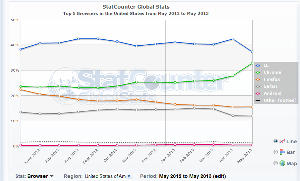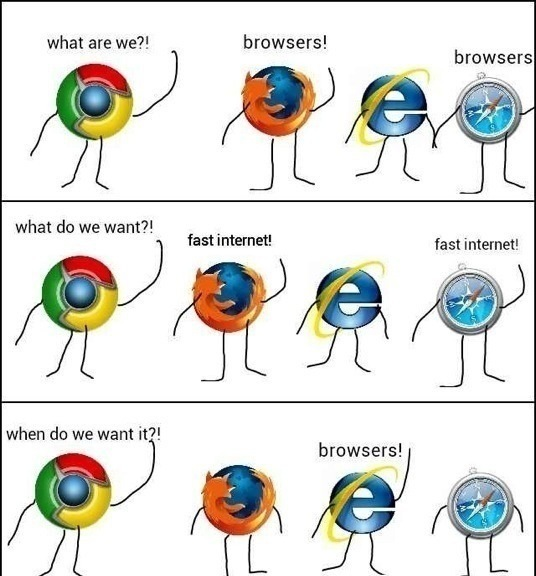Still Using Windows XP? Check your Browser!
Windows XP was a popular version of Windows. So popular, in fact, that some people are still using it. As of May 2013, nearly 40% of all desktop computers were still running XP, which slightly less than the combined percentage of computers running Windows Vista, 7, and 8. The rest are running either Apple's OS X or Linux. If you're in the XP group and you're still using Internet Explorer, it's time to make a change.
Later this year, Microsoft will release Internet Explorer 11. Windows XP, however, can't use any version of Internet Explorer later than version 8 and version 8 doesn't support the current language of Websites, HTML5.
Granted, by using technologies such as Moderizr (www.modernizr.com), people who design websites can provide an acceptable experience for Microsoft's perennially behind-the-curve browser, even for version 8; but there's little reason for XP users to put up version 8, which was released in 2008 with support that was well behind the times even then.
Explorer 11, which will be provided with Windows 8.1 is expected to provide acceptable support for HTML5 and CSS3 without having to rely on the workarounds generated by Modernizr code. Although version 8 of IE supported some minimal HTML5 functionality and at least recognized version 3 of the cascading stylesheet (CSS) specification, it wasn't until version 9 (released in March 2011) that IE caught up to where browsers such as Chrome and Firefox were in 2009.
Sometimes I wonder why Microsoft even bothers to continue developing Internet Explorer. And, although I understand that some computer users accept Explorer because it came with their computers, given the ease of downloading and installing a better browser, I wonder why so many people still use IE.
 Although Chrome has led the way since June 2012, IE is still the second most popular browser in the world. Numbers for Firefox are slowly declining. Safari is popular on Macs and Opera has fans in Europe, but the big 3 are Chrome, IE, and Firefox.
Although Chrome has led the way since June 2012, IE is still the second most popular browser in the world. Numbers for Firefox are slowly declining. Safari is popular on Macs and Opera has fans in Europe, but the big 3 are Chrome, IE, and Firefox.
What's strange and, in my view, a bit sad, is the fact that Internet Explorer is still the leader in the United States and by a significant margin. Why do so many computer users put up with such a substandard browser? Chrome is catching on and appears to be on track to exceed IE's numbers within the next few months. Firefox use is declining, but slowly. Opera doesn't even show up in US statistics.
StatCounter reports useful information about the people who visit websites. It's information that website designers can use to determine which features they may safely enable. For example the browser summary for the United States is here, but look around the site to find additional infomation.
Browser Annoyances
Even the mighty Google doesn't create a browser that's immune from complaints. I often have a lot of browser windows open. So many, in fact, that invariably have 2 browsers open: 1 instance of Chrome (which overall is faster than Firefox and quite a bit lighter on system resources) and 1 instance of Firefox. Each has several tabs open.
![]() Chrome, however, insists on placing a "close" indicator on every single tab. If you have a lot of tabs open, these X icons take up a lot of usable space and, even worse, they're very easy to click when you're trying to select a tab. Instead, you close it.
Chrome, however, insists on placing a "close" indicator on every single tab. If you have a lot of tabs open, these X icons take up a lot of usable space and, even worse, they're very easy to click when you're trying to select a tab. Instead, you close it.
In fact, this is one of the annoyances that seems to generate a lot of complaints but Google knows best and won't even consider making it an option. This is why Firefox is my primary browser.
![]() By default, Firefox has the same annoying behavior but it's possible to configure Firefox so that only the current tab has a close button, so that no tabs have a close button, or so that the close button for the current tab appears at the far right edge of the screen (this was the default behavior when tabs first became available.) I have modified Firefox so that none of the tabs has a close button and I wish that I could do the same for Chrome.
By default, Firefox has the same annoying behavior but it's possible to configure Firefox so that only the current tab has a close button, so that no tabs have a close button, or so that the close button for the current tab appears at the far right edge of the screen (this was the default behavior when tabs first became available.) I have modified Firefox so that none of the tabs has a close button and I wish that I could do the same for Chrome.
 The process for Firefox is both straightforward and easy. Simply open a new tab and type about:config in the address bar. Type browser.tabs.closeButtons in the search box and modify the setting to suit your preference:
The process for Firefox is both straightforward and easy. Simply open a new tab and type about:config in the address bar. Type browser.tabs.closeButtons in the search box and modify the setting to suit your preference:
- 0: Display a close button on the active tab only.
- 1: Display close buttons on all tabs. (Default)
- 2: Don’t display any close buttons.
- 3: Display a single close button at the end of the tab strip. (Firefox 1.x behavior)
You don't even have to restart the browser.
 Why Firefox is Better than IE
Why Firefox is Better than IE
- Stability
- Multi-platform support (IE doesn't run on Macs, except for an antique version of IE)
- Speed
- Security
- Mozbackup
- Sync on multiple machines without Windows 8
- Better support of standards
Why Chrome is Better than IE
- Speed
- Lower resource requriement
- Security
- Sync on multiple machines without Windows 8
- Better support of standards
- Ability to protect one tab from others
The View from ThinkGeek.com
Here's an image that appeared on ThinkGeek's Facebook timeline. I don't know if it's an original ThinkGeek image, but it illustrates one of the reasons that you might want to choose a browser other than Internet Explorer.
Windows 8.1 Preview - Before you Download
On June 26, Microsoft will make a preview edition of Windows 8.1 available to the general public. If you're using Windows 8, there are reasons why you might want to download the public preview, but there are also some good reasons why you might want to wait until the final version is released later this year.
The most significant contraindication (as a doctor might say) is this: If you install the preview version over an existing Windows 8 installation, all installed apps will be deleted. OK, maybe you can survive that, particularly if you don't use a lot of the apps.
The real kick in the head comes when the final 8.1 code is released: Install that over a preview version and you'll lose all of your apps again. But that's not all. Any installed desktop applications will also be removed. So if you have a computer that you use for testing, the public preview might be a worthwhile download.
Not that you'd ever install a preview application on a production machine, but maybe you have a second computer that has a lot of applications on it but isn't your primary production computer. Maybe you would want to try the preview version there.
But if you'd prefer not to go through the hassle of reinstalling your Metro apps twice and reinstalling all of your desktop applications, wait. Those who upgrade from the release version of Windows 8 to the release version of Windows 8.1 won't have to reinstall everything.
So I won't be installing the preview version on any computer, but by virtue of a TechNet membership, I expect to have access to the release-to-manufacturing (RTM) code 4 to 6 weeks before it becomes generally available. Once I have that, I will be able to update an existing computer that contains many existing Metro and desktop applications. Then I'll be able to let you know how well it performs.
Promised Changes (Everything New is Old Again, or Vice Versa)
Picking through the tea leaves scattered on various Microsoft blogs, I believe that I know what's in store.
- Some companies allow employees to attach their own devices to the corporate network. Whether you think this is a good thing or not (and I don't), it's a reality and Windows 8.1 will address that. The operating system will allow employees' devices to fit somewhere between devices that have joined a domain and those that have not. Given the company's policies, certain privileges can be granted to these "midway" devices.
- If you use your own Windows 8.1 device both inside and outside the office, a special "Work Folders" area makes it possible to sync data between the portable device and corporate assets. Again, the IT staff needs to determine whether this is a good idea or not (I would again say not).
- Mobile device management will allow those who use mobile devices on a corporate LAN to provide a consistent look and feel across all of their devices. This is essentially an extension of the existing synchronization option on Windows 8 computers.
- Other changes make it possible to publish access to corporate resources and maintain security by means of multi-factor authentication, improve the virtual desktop infrastructure (VDI) on Windows Server 2012 systems, and the ability to print directly to a Wi-Fi enabled printer.
- Virtual private network (VPN) will have better support both on standard Windows devices and those that run Windows RT.
- Improved power savings when using mobile broadband. When Windows 8 was launched, broadband access used radios that were separate components within the computer's case. This took a toll on battery life. Windows 8.1 will support radios that are integral parts of the hardware.
- Metro apps follow users with "Windows To Go". Whether you buy an app or use a free app from the Windows store, the app may be configured to appear on any or all of your computers.
- To mitigate some of the concerns raised by attaching personal devices to corporate resources, Windows 8.1 will offer remote business data removal. Corporate IT staff will be able to control corporate data on personal devices, encrypt it, or even delete it.
- Better biometric identification. Windows 8.1 will be optimized for fingerprint based biometrics and will include a standard fingerprint enrollment experience that will work with a variety of readers. Microsoft says that new readers include "liveliness detection" that prevents spoofing a fingerprint with a silicon copy (or, presumably, with a finger severed from the owner's hand. Sorry.)
- Improved data encryption. Full device encryption that has been used on RT devices and the Windows 8 phone will now be available for desktop and notebook systems and it will be enabled by default. Microsoft says that data on any connected standby device will also be automatically encrypted.
- For those who still insist on using Internet Explorer, version 11 will be included. Web pages should load faster and settings such as favorites and tabs can be shared across all of your Windows 8.1 computers. Microsoft says that IE 11 will be more resistant to malware.
- Microsoft's antivirus and anti-malware application, Windows Defender, will gain network behavior monitoring that will provide better detection for less-known malware variants.
- Users will be able to boot directly to the desktop instead of having to stop at the Metro interface. This apparently is important to some people and, as you already know, a quasi-start button will return to needlessly clutter the screen.
The key, of course, will be how well all of these new features work. I won't be able to discuss that until I've been able to work with version 8.1. So stay tuned.
Short Circuits
The Race to Tell
High tech companies seem to be engaged in another race, this one to see who can release the most information the fastest about which government agencies have asked for information and what they've provided. Take Google's request to the Foreign Intelligence Surveillance (FISA) Court as one example of the trend.
Google, the company that has more information about you and me than the FBI, CIA, KGB, Mossad, MI6, and SMERSH combined, now wants to tell us what those various lesser agencies are asking for. Prior to asking the FISA Court for permission to spill the beans, Google made similar requests to the FBI director and the director of national intelligence.
Facebook, Yahoo, Microsoft, and Apple have all requested permission to divulge information about the requests, have been granted that permission, and have described the requests. Google, on the other hand, has since 2010 released annual reports detailing government requests for information.
The new request from Google says that it has a right under the First Amendment to publish information about the number of requests submitted and the number of accounts that the requests affect.
When Apple released its report, the company noted that it doesn't provide information to the government when certain of its products are used. Apple's Imessage and FaceTime chat services are examples. This information isn't provide because the services are encrypted. Apple says that it doesn't release information about the use of Apple Maps or requests to the virtual assistant, Siri, because information about those services isn't retained in a way that can link it to specific people.
Apple says that it has handled 4000 to 5000 requests for customer data and that those requests affect 9000 to 10,000 accounts; those numbers reflect requests from all government agencies during the 6 months that ending in May. If all that seems a bit vague, that is by design. Companies were given permission to release the information, but told that they must list requests in blocks of 1000 and that requests from all federal, state, and local government agencies must be included with the FISA requests.
As a result, it's unclear how many requests were made on the grounds of "national security" and how many were filed by local police, who might have been trying to find a missing person. According to Apple, the most common kinds of requests it receives are those from local police agencies.
Google sees the issue as one of public relations and says that it has been as forthcoming as it legally can be and that it is now asking for additional permission from the government in the interest of repairing what it terms "harm" to its reputation caused by "false or misleading" media reports.
Facebook, Microsoft, and Yahoo have all issued similarly vague reports about government information requests. Facebook reported 9000 to 10,000 requests in the 6 months ending in December. Microsoft indicated 6000 to 7000 requests during the same period. Yahoo says that it handled 12,000 to 13,000 requests in the 6 months ending in May.
Digging Up E.T.
Alamogordo, New Mexico, is where E.T. went to die. Not the space alien, but the Atari game based on the movie. Thirty years ago, Atari had released a computer game, but nobody wanted it. Atari apparently decided to dump the games in a landfill and that landfill just happened to be in Alamogordo.
Beneath the dirt is concrete. Beneath the concrete -- maybe there are thousands (or millions?) of E.T. game cartridges.
The landfill is where an Air Force base used to be. The state’s Museum of Space History dumped its trash there in the 1980s. Some of the trash might have been E.T. games that nobody wanted. Why did nobody want them? Gamers at the time characterized this game as possibly the worst game of all time.
But now somebody thinks there's a market for the worst game of all time.
If they're there. And there's some question about that. Snopes.com says it has found no proof that the game cartridges are there. At least not millions. But some local residents have reported extracting ancient games from the landfill.
The game was churned out in just 5 weeks so it could be on sale in time for the Christmas shopping season in 1982. Atari paid more than $20 million for rights to use the E.T. character. The game was bad but more than 5 million copies sold. Half of those were returned for a refund and are now rumored to be in the New Mexico landfill.
Pac-Man cartridges might be there, too. Atari managed to make more of those games than the number of consoles that existed. Those games could also be buried there. Or not.
A Los Angeles company, Fuel Entertainment, believes that something is there and has obtained a permit to excavate the Alamogordo landfill between now and the end of the year.
If Fuel Entertainment finds something, you can bet you'll hear more about it. And probably on late-night TV infomercials.
And Speaking of Antiques ...
An account by Mike Cassidy in the San Jose Mercury News about Steve Wozniak and 5 Apple 1 computers will probably make you smile. About 50 Apple 1 computers probably exist and one of them recently sold for $671,400. Keep in mind that this is a computer with less computing power than the average digital clock.
Cassidy's story describes a visit by Apple co-founder Steve Wozniak to History San Jose, to see 5 of the remaining Apple 1 computers: "It was a little like having Stradivari over to your house to make sure your violin is in tune, or having Rembrandt stop by to touch up that painting on your wall, but there was Steve Wozniak on Tuesday standing over a table of five rare Apple 1 computers at History San Jose, regaling a small crowd with war stories."
Although other "personal computers" existed before Wozniak and Jobs put the Apple 1 on sale, the Apple 1 was the first device that was affordable, even if it wasn't very useful. There was no keyboard. No mouse. Not even a case. It was just a circuit board, standard green, and hobbyists had to provide a power supply, a monitor, and a keyboard. What about a mouse? Sorry, but those hadn't been invented yet.
Why was Woz at the museum? I'll let Cassidy tell that part: "Word had spread that History San Jose was going to attempt to boot up its machine. Wendell Sander, a brilliant engineer known as the father of the Apple III, agreed to bring his. Allen Baum, a high school friend of Woz and a former Apple employee, brought his, too. Apple 1 owner Andy Jong, a Berkeley computer store owner with early Apple ties, thought, why not? And Woz himself grabbed his on the way out the door, too."
Did it work?
If you want to find out, you'll just have to follow the link earlier in this report and read Cassidy's story. You'll also find some videos of the event on the Mercury News website. Here's one of the videos ...
Fuzzy Picture Specialist Instagram to Offer Videos
Instagram, the company that made a fortune by making it possible for people to use smart phone cameras to create images that look like they were taken by $5 cameras from the 1950s plans to branch out. Now you can create and upload Instagram videos.
The company is now a part of Facebook and has about 100 million users.
Instagram says the video project has been in development for the past 2 years and numerous rumors about its imminent release have surfaced over the past several weeks.
The Instagram video offering will go head-to-head with the competing Vine video service from Twitter. Vine claims 13 million users. The ubiquity of cameras that can also capture video is the driving force behind both of the services as well as video services such as Viddy and Socialcam. And, of course, there are the established video sources such as YouTube and Vimeo.
 When measured in Internet time where a few weeks can seemingly be the equivalent of a year in real time, Facebook could be seen as arriving on the scene just a bit too late. So far, when it comes to replicating the popularity of Instagram for video users, Twitter's Vine appears to have the lead. Vine's videos are limited to 6 seconds. Viddy allows 30 seconds. By those standards, a 3 minute video featuring Maru* on YouTube, would seem like a feature-length film.
When measured in Internet time where a few weeks can seemingly be the equivalent of a year in real time, Facebook could be seen as arriving on the scene just a bit too late. So far, when it comes to replicating the popularity of Instagram for video users, Twitter's Vine appears to have the lead. Vine's videos are limited to 6 seconds. Viddy allows 30 seconds. By those standards, a 3 minute video featuring Maru* on YouTube, would seem like a feature-length film.
If Facebook tries to incorporate video into its already overburdened interface, it runs the risk of alienating users. Younger users, to some extent, are already shunning Facebook.
*A most famous Japanese cat for those who don't keep up with these trends.
The new video features are available now on Apple and Android phones. Videos can be 15 to 30 seconds in length, compared to Vine's 6 seconds. The Instagram app will look much as it always has, but now users will need to choose between a single shot or a video. And of course there are filters--13 of them so far. Convert the video to black and white, blur it, change the brightness. And there's also "Cinema Mode" that will attempt to eliminate the jiggles that usually occur in hand-held video.
